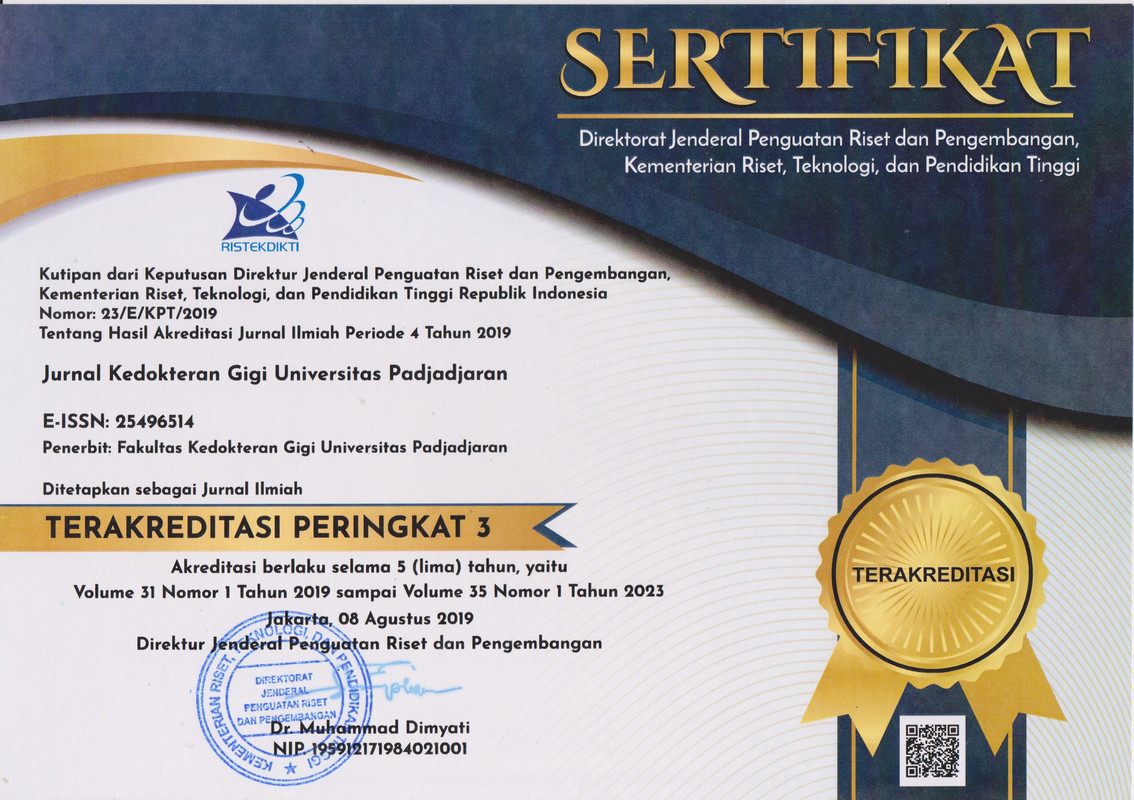Isolasi dan karakterisasi bakteri kariogenik pada pasien di Rumah Sakit Gigi dan Mulut Universitas Jenderal Soedirman
Abstract
ABSTRAK
Pendahuluan: Karies gigi adalah hilangnya struktur kimia penyusun gigi yang disebabkan oleh interaksi kompleks antara mikroorganisme rongga mulut pada plak gigi, diet dan faktor host. Pencegahan karies dapat dilakukan dengan manipulasi bakteri yang diarahkan pada bakteri kariogenik dominan yang diisolasi dari karies. Penelitian ini bertujuan untuk mengisolasi dan mengkarakterisasi bakteri kariogenik pada pasien yang terdiagnosis pulpitis di Rumah Sakit Gigi dan Mulut Universitas Jenderal Soedirman pada bulan Desember 2020 – Februari 2021. Metode: Penelitian observasional deskriptif ini dilakukan dengan consecutive sampling. Sampel penelitian diambil dari karies gigi dengan kedalaman dentin pada 5 pasien di RSGM Unsoed yang terdiagnosis pulpitis. Identifikasi dilakukan dengan menumbuhkan bakteri pada media agar darah, Mannitol Salt Agar (MSA), dan Man Rogosa Sharpe Agar (MRSA) kemudian dilakukan pengamatan morfologi, perhitungan koloni bakteri, pewarnaan Gram dan uji-uji biokimia. Hasil : Jenis bakteri yang dapat diidentifikasi dari karies adalah Staphylococcus aureus (80%), Staphylococcus intermedius (40%), Coagulase Negative Staphylococcus (60%), Lactobacillus sp (80%) dan Lactobacillales Gram positif (20%). Simpulan: Didapatkan isolat yang diduga bakteri Staphylococcus aureus, Staphylococcus intermedius, Coagulase Negative Staphylococcus (CoNS), Lactobacillus sp dan Lactobacillales Gram positif yang diisolasi dari karies gigi.
Kata kunci: karies gigi, bakteri kariogenik, staphylococcus aureus, lactobacillus sp
Isolation and characterization of cariogenic bacteria in patient at Universitas Jenderal Soedirman Dental Hospital
ABSTRACT
Introduction: Dental caries is the loss of the chemical structure of the teeth that is caused by complex interactions between oral microorganisms on dental plaque, diet and host factors. Caries prevention can be done by manipulation of bacteria directed at the dominant cariogenic bacteria isolated from caries. This study aims to isolate and characterize cariogenic bacteria in patients at the Universitas Jendral Soedirman Dental Hospital from Desember 2020 until Februari 2021. Methods: This descriptive observational study was conducted with consecutive sampling. Samples were taken from dental caries at dentine depth in 5 patients at Universitas Jenderal Soedirman Dental Hospital who were diagnosed with pulpitis. Identification was done by growing bacteria on blood agar media, Mannitol Salt Agar (MSA) and Man Rogosa Sharpe Agar (MRSA) then morphological observations, bacterial colony counting, Gram staining and biochemical tests were done. Results: The types of bacteria that can be identified from caries are Staphylococcus aureus (80%), Staphylococcus intermedius (40%), Coagulase Negative Staphylococcus (60%), Lactobacillus sp. (80%) and Gram positive Lactobacilllales (20%). Conclusion: We found isolates suspected to be Staphylococcus aureus, Staphylococcus intermedius, Coagulase Negative Staphylococcus (CoNS), Lactobacillus sp and Gram positive Lactobacilllales isolated from dental caries.
Keywords: dental caries, cariogenic bacteria, staphylococcus aureus, lactobacillus sp
Keywords
Full Text:
PDFReferences
DAFTAR PUSTAKA
Newman MG, Takei HH, Klokkevold PR, Carranza FA. Newman and Carranza’s Clinical Periodontology. 13th edition. Philadelphia: Elsevier; 2019. p. 256-257.
Kathariya R, Jain H, Jadhav T. To pack or not to pack: the current status of periodontal dressings. J Appl Biomater Funct Mater 2015 Jul 4;13(2):e73–86. DOI: 10.5301/jabfm.5000215.
Addy M, Dolby AE. The use of chlorhexidine mouthwash compared with a periodontal dressing following the gingivectomy procedure. J Clin Periodontol. 1976 Feb;3(1):59-65. 7-
Heitz F, Heitz-Mayfield Lj, Lang NP. Effects of post-surgical cleansing protocols on early plaque control in periodontal and/or periimplant wound healing. J Clin Periodontol. 2004 Nov;31(11):1012-8
Newman, Takei, Klokkevold, and Carranza FA. 2015. General Principles of Periodontal Surgery; Carranza’s Clinical Periodontology. 12th e. London, New York: PA; 2015. 602
Pradita AU, Dhartono AP, Ramadhany CA, and Taqwim A. Periodontal dressing-containing green tea epigallocathechin gallate increases fibroblasts number in gingival artifical wound model. J Dent Indo 2013;20(3):68 –72. doi: 10.14693/jdi.v20i3.197
Habiboallah G, et al. Enhancement of gingival wound healing by local application of silver nanoparticles periodontal dressing following surgery: a histological assessment in animal model. Modern Research in Inflammation 2014;3:128-138. doi: 10.4236/mri.2014.33016
David K, Neetha JS, Swat P. Periodontal dressing: an informed view. J Pharm Biomed Sci 2013;26(26):269-272.
Askari M, Saffarpour A, Purhashemi J, Beyki A. Effect of propolis extract in combination with eugenol-free dressing (COE-PAK™TM) on pain and wound healing after crown-lengthening: a randomized clinical trial. J Dent (Shiraz) 2017 Sep;18(3):173–180. PMCID: PMC5634356
Garg P, Tyagi SP, Sinha DJ, Singh UP, Malik V, Maccune ER. Comparison of antimicrobial efficacy of propolis, Morinda citrifolia, Azadirachta indica, triphala, green tea polyphenols and 5.25% sodium hypochlorite against Enterococcus fecalis biofilm. Saudi Endod J. 2014;4:122-7. doi: 10.4103/1658-5984.138141
Sabir A, Sumidarti A. Interleukin-6 expression on inflamed rat dental pulp tissue after capped with Trigona sp. propolis from south Sulawesi, Indonesia. Saudi J Biol Sci 2017 Jul;24(5):1034-1037. doi: 10.1016/j.sjbs.2016.12.019.
López-Valverde N, Pardal-Peláez B, López-Valverde A, Flores-Fraile J, Herrero- Hernández S, Macedo-de-Sousa B. 2021. Effectiveness of propolis in the treatment of periodontal disease: updated systematic review with meta-analysis. Antioxidants (Basel) 2021; 10(2):269. doi: 10.3390/antiox10020269
Kadkhodazadeh M, Baghani Z, Torshabi M, Basirat B. In vitro comparison of biological effects of COE-PAK™ and RESO-PAC™ dresing periodontals. J Oral Maxillofac Res 2017 Mar 31;8(1):e3. doi: 10.5037/jomr.2017.8103
Przybyłek I, Karpiński TM. Antibacterial properties of propolis. Molecules 2019;24(11):2047. doi: 10.3390/molecules24112047.
Anjum SI, et al. Composition and functional properties of propolis (bee glue): a review. Saudi Journal of Biological Sciences 2019;26(7):1695–1703. doi: 10.1016/j.sjbs.2018.08.013.
Ghasemi FS, Eshraghi SS, Andalibi F, Hooshyar H, KalantarNeyestanaki D, Samadi A, et al. Anti-bacterial effect of propolis extract in oil against different bacteria. Zahedan J Res Med Sci 2017;19(3):e7225. doi: 10.5812/zjrms.7225
Almuhayawi MS. Propolis as a novel antibacterial agent. Saudi Journal of Biological Sciences 2020;27(11):3079–3086. doi: 10.1016/j.sjbs.2020.09.016.
Al-waili N. Mixing two different propolis samples potentiates their antimicrobial activity and wound healing property: A novel approach in wound healing and infection. Vet World 2018 Aug;11(8):1188-1195. doi: 10.14202/vetworld.2018.1188-1195.
DOI: https://doi.org/10.24198/jkg.v35i1.41439
Refbacks
- There are currently no refbacks.
Copyright (c) 2023 Jurnal Kedokteran Gigi Universitas Padjadjaran
INDEXING & PARTNERSHIP

Jurnal Kedokteran Gigi Universitas Padjadjaran dilisensikan di bawah Creative Commons Attribution 4.0 International License






.png)

















